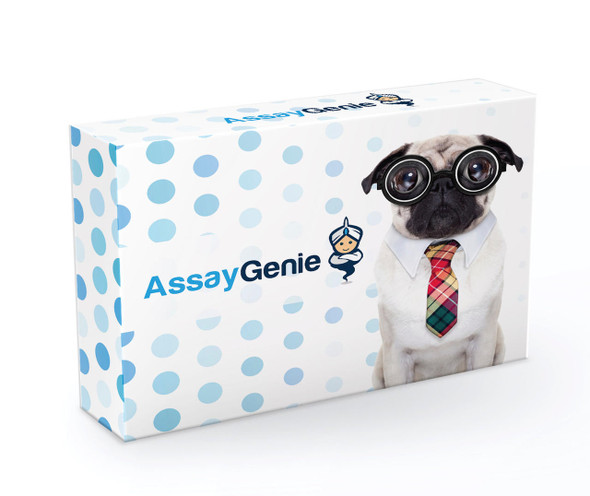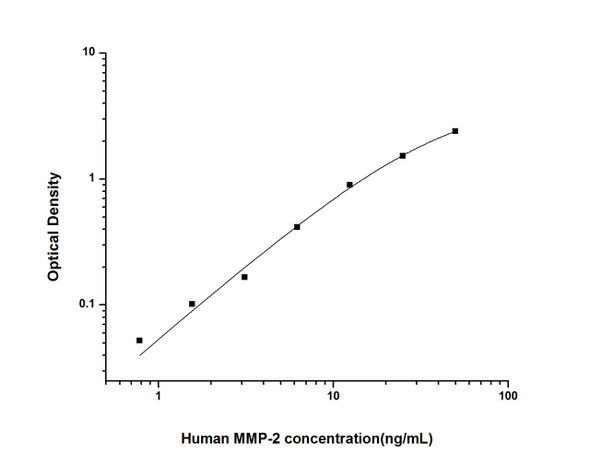Mouse Cardiovascular ELISA Kits
Mouse MMP-2 (Matrix Metalloproteinase 2) ELISA Kit (MOES01259)
- SKU:
- MOES01259
- Product Type:
- ELISA Kit
- Size:
- 96 Assays
- Uniprot:
- P33434
- Sensitivity:
- 0.09ng/mL
- Range:
- 0.16-10ng/mL
- ELISA Type:
- Sandwich
- Synonyms:
- MMP2, CLG4, CLG4A, MMP-II, MONA, TBE-1, Gelatinase A
- Reactivity:
- Mouse
- Sample Type:
- Serum, plasma and other biological fluids
- Research Area:
- Cardiovascular
Description
| Assay type: | Sandwich |
| Format: | 96T |
| Assay time: | 4.5h |
| Reactivity: | Mouse |
| Detection Method: | Colormetric |
| Detection Range: | 0.16-10 ng/mL |
| Sensitivity: | 0.10 ng/mL |
| Sample Volume Required Per Well: | 100µL |
| Sample Type: | Serum, plasma and other biological fluids |
| Specificity: | This kit recognizes Mouse MMP-2 in samples. No significant cross-reactivity or interference between Mouse MMP-2 and analogues was observed. |
This ELISA kit uses Sandwich-ELISA as the method. The micro ELISA plate provided in this kit has been pre-coated with an antibody specific to Mouse MMP-2. Standards or samples are added to the appropriate micro ELISA plate wells and combined with the specific antibody. Then a biotinylated detection antibody specific for Mouse MMP-2 and Avidin-Horseradish Peroxidase (HRP) conjugate are added to each micro plate well successively and incubated. Free components are washed away. The substrate solution is added to each well. Only those wells that contain Mouse MMP-2, biotinylated detection antibody and Avidin-HRP conjugate will appear blue in color. The enzyme-substrate reaction is terminated by adding Stop Solution and the color turns yellow. The optical density (OD) is measured spectrophotometrically at a wavelength of 450 nm ± 2 nm. The OD value is proportional to the concentration of Mouse MMP-2. The concentration of Mouse MMP-2 in samples can be calculated by comparing the OD of the samples to the standard curve.
| UniProt Protein Function: | MMP2: Ubiquitinous metalloproteinase that is involved in diverse functions such as remodeling of the vasculature, angiogenesis, tissue repair, tumor invasion, inflammation, and atherosclerotic plaque rupture. As well as degrading extracellular matrix proteins, can also act on several nonmatrix proteins such as big endothelial 1 and beta-type CGRP promoting vasoconstriction. Also cleaves KISS at a Gly-|-Leu bond. Appears to have a role in myocardial cell death pathways. Contributes to myocardial oxidative stress by regulating the activity of GSK3beta. Cleaves GSK3beta in vitro. Interacts (via the C-terminal hemopexin-like domains- containing region) with the integrin alpha-V/beta-3; the interaction promotes vascular invasion in angiogenic vessels and melamoma cells. Interacts (via the C-terminal PEX domain) with TIMP2 (via the C-terminal); the interaction inhibits the degradation activity. Interacts with GSK3B. Aspirin appears to inhibit expression. Produced by normal skin fibroblasts. PEX is expressed in a number of tumors including gliomas, breast and prostate. Inhibited by histatin-3 1/24 (histatin-5). Belongs to the peptidase M10A family. |
| UniProt Protein Details: | Protein type:Protease; Secreted; Apoptosis; Cell development/differentiation; EC 3. 4. 24. 24; Secreted, signal peptide; Motility/polarity/chemotaxis Cellular Component: extracellular matrix; proteinaceous extracellular matrix; extracellular space; sarcomere; membrane; mitochondrion; cytoplasm; plasma membrane; extracellular region; nucleus Molecular Function:peptidase activity; zinc ion binding; hydrolase activity; metallopeptidase activity; metal ion binding; metalloendopeptidase activity; fibronectin binding Biological Process: response to drug; cell migration; intramembranous ossification; positive regulation of apoptosis; tissue remodeling; negative regulation of cell adhesion; proteolysis; axon regeneration in the peripheral nervous system; blood vessel maturation; negative regulation of vasoconstriction; collagen catabolic process; response to hydrogen peroxide; ovarian follicle development; response to estrogen stimulus; skeletal morphogenesis; response to mechanical stimulus; positive regulation of innate immune response; response to hypoxia; response to oxidative stress; angiogenesis; embryo implantation; positive regulation of cell migration |
| UniProt Code: | P33434 |
| NCBI GenInfo Identifier: | 461766 |
| NCBI Gene ID: | 17390 |
| NCBI Accession: | P33434. 1 |
| UniProt Related Accession: | P33434 |
| Molecular Weight: | 65,883 Da |
| NCBI Full Name: | 72 kDa type IV collagenase |
| NCBI Synonym Full Names: | matrix metallopeptidase 2 |
| NCBI Official Symbol: | Mmp2 |
| NCBI Official Synonym Symbols: | GelA; Clg4a; MMP-2 |
| NCBI Protein Information: | 72 kDa type IV collagenase; gelatinase A; 72kD gelatinase; 72kDa gelatinase; 72 kDa gelatinase; 72kD type IV collagenase; 72kDa type IV collagenase; matrix metalloproteinase 2; matrix metalloproteinase-2 |
| UniProt Protein Name: | 72 kDa type IV collagenase |
| UniProt Synonym Protein Names: | 72 kDa gelatinase; Gelatinase A; Matrix metalloproteinase-2; MMP-2 |
| Protein Family: | Matrix metalloproteinase |
| UniProt Gene Name: | Mmp2 |
| UniProt Entry Name: | MMP2_MOUSE |
As the OD values of the standard curve may vary according to the conditions of the actual assay performance (e. g. operator, pipetting technique, washing technique or temperature effects), the operator should establish a standard curve for each test. Typical standard curve and data is provided below for reference only.
| Concentration (ng/mL) | O.D | Average | Corrected |
| 10 | 2.325 2.347 | 2.336 | 2.277 |
| 5 | 1.523 1.523 | 1.523 | 1.464 |
| 2.5 | 0.811 0.805 | 0.808 | 0.749 |
| 1.25 | 0.338 0.374 | 0.356 | 0.297 |
| 0.63 | 0.216 0.186 | 0.201 | 0.142 |
| 0.31 | 0.15 0.142 | 0.146 | 0.087 |
| 0.16 | 0.103 0.109 | 0.106 | 0.047 |
| 0 | 0.054 0.064 | 0.059 | -- |
Precision
Intra-assay Precision (Precision within an assay): 3 samples with low, mid range and high level Mouse MMP-2 were tested 20 times on one plate, respectively.
Inter-assay Precision (Precision between assays): 3 samples with low, mid range and high level Mouse MMP-2 were tested on 3 different plates, 20 replicates in each plate.
| Intra-assay Precision | Inter-assay Precision | |||||
| Sample | 1 | 2 | 3 | 1 | 2 | 3 |
| n | 20 | 20 | 20 | 20 | 20 | 20 |
| Mean (ng/mL) | 0.50 | 0.90 | 4.10 | 0.50 | 0.90 | 4.10 |
| Standard deviation | 0.03 | 0.05 | 0.18 | 0.03 | 0.04 | 0.20 |
| C V (%) | 6.00 | 5.56 | 4.39 | 6.00 | 4.44 | 4.88 |
Recovery
The recovery of Mouse MMP-2 spiked at three different levels in samples throughout the range of the assay was evaluated in various matrices.
| Sample Type | Range (%) | Average Recovery (%) |
| Serum (n=5) | 94-106 | 101 |
| EDTA plasma (n=5) | 86-98 | 91 |
| Cell culture media (n=5) | 93-107 | 98 |
Linearity
Samples were spiked with high concentrations of Mouse MMP-2 and diluted with Reference Standard & Sample Diluent to produce samples with values within the range of the assay.
| Serum (n=5) | EDTA plasma (n=5) | Cell culture media (n=5) | ||
| 1:2 | Range (%) | 99-110 | 95-110 | 87-104 |
| Average (%) | 105 | 102 | 95 | |
| 1:4 | Range (%) | 100-114 | 85-99 | 96-108 |
| Average (%) | 105 | 91 | 102 | |
| 1:8 | Range (%) | 98-111 | 81-92 | 95-107 |
| Average (%) | 105 | 86 | 101 | |
| 1:16 | Range (%) | 95-112 | 83-95 | 92-105 |
| Average (%) | 102 | 89 | 99 |
An unopened kit can be stored at 4°C for 1 month. If the kit is not used within 1 month, store the items separately according to the following conditions once the kit is received.
| Item | Specifications | Storage |
| Micro ELISA Plate(Dismountable) | 8 wells ×12 strips | -20°C, 6 months |
| Reference Standard | 2 vials | |
| Concentrated Biotinylated Detection Ab (100×) | 1 vial, 120 µL | |
| Concentrated HRP Conjugate (100×) | 1 vial, 120 µL | -20°C(shading light), 6 months |
| Reference Standard & Sample Diluent | 1 vial, 20 mL | 4°C, 6 months |
| Biotinylated Detection Ab Diluent | 1 vial, 14 mL | |
| HRP Conjugate Diluent | 1 vial, 14 mL | |
| Concentrated Wash Buffer (25×) | 1 vial, 30 mL | |
| Substrate Reagent | 1 vial, 10 mL | 4°C(shading light) |
| Stop Solution | 1 vial, 10 mL | 4°C |
| Plate Sealer | 5 pieces | |
| Product Description | 1 copy | |
| Certificate of Analysis | 1 copy |
- Set standard, test sample and control (zero) wells on the pre-coated plate and record theirpositions. It is recommended to measure each standard and sample in duplicate. Note: addall solutions to the bottom of the plate wells while avoiding contact with the well walls. Ensuresolutions do not foam when adding to the wells.
- Aliquot 100µl of standard solutions into the standard wells.
- Add 100µl of Sample / Standard dilution buffer into the control (zero) well.
- Add 100µl of properly diluted sample (serum, plasma, tissue homogenates and otherbiological fluids) into test sample wells.
- Cover the plate with the sealer provided in the kit and incubate for 90 min at 37°C.
- Aspirate the liquid from each well, do not wash. Immediately add 100µL of BiotinylatedDetection Ab working solution to each well. Cover the plate with a plate seal and gently mix. Incubate for 1 hour at 37°C.
- Aspirate or decant the solution from the plate and add 350µL of wash buffer to each welland incubate for 1-2 minutes at room temperature. Aspirate the solution from each well andclap the plate on absorbent filter paper to dry. Repeat this process 3 times. Note: a microplatewasher can be used in this step and other wash steps.
- Add 100µL of HRP Conjugate working solution to each well. Cover with a plate seal andincubate for 30 min at 37°C.
- Aspirate or decant the solution from each well. Repeat the wash process for five times asconducted in step 7.
- Add 90µL of Substrate Reagent to each well. Cover with a new plate seal and incubate forapproximately 15 min at 37°C. Protect the plate from light. Note: the reaction time can beshortened or extended according to the actual color change, but not by more than 30min.
- Add 50 µL of Stop Solution to each well. Note: Adding the stop solution should be done inthe same order as the substrate solution.
- Determine the optical density (OD value) of each well immediately with a microplate readerset at 450 nm.






